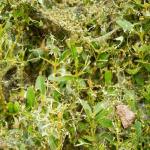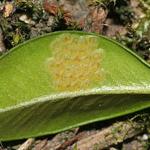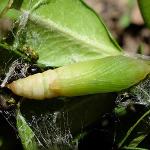Box Tree Moth Monitoring & Trapping
Box Tree Moth Scientific Name: Cydalima perspectalis
Introduction:
The box tree moth (Cydalima perspectalis) is a non-native insect that originated in the temperate and subtropical regions of Asia. It was found to be invasive in Europe in 2007 and has since spread to western Asia, northern Africa, Canada (2018), and the United States (2021). It was first detected in Massachusetts in communities on Cape Cod (Barnstable County) in August of 2023. It is important that if you suspect you have found this insect in Massachusetts, especially outside of Barnstable County, you report it to MDAR, here: https://massnrc.org/pests/report.aspx . For a map of where box tree moth occurs in Massachusetts, visit: https://bit.ly/BTMPestDash .
Box Tree Moth ID:
A fact sheet with more information about the identification, life cycle, host plants, damage, and management strategies for box tree moth can be found here: https://ag.umass.edu/landscape/fact-sheets/box-tree-moth and here: https://www.aphis.usda.gov/plant-pests-diseases/box-tree-moth . For the purposes of monitoring box tree moth, some of this information is summarized below. Additional details can be found in the above fact sheets.
|
Life Stage |
Size |
Color & Markings |
Location |
|
Adults
|
1.6-1.8 inch wide wings |
White with a brown head and abdomen; wings are white and slightly iridescent, with an irregular thick brown border. Part of the adult (both male and female) population has completely brown wings with a small white streak on each forewing. |
Males & females fly. |
|
Eggs
|
0.04 inches |
Pale yellow; flat. |
Gelatinous mass of 5-20 on underside of host plant leaves. |
|
Larvae/Caterpillars
|
1.6 inches long at maturity |
Newly hatched caterpillars have black heads and are green to yellow in color. As they age, the coloration of the caterpillar changes even further and dark brown stripes develop on the body and a black spot appears on the head. The most mature caterpillars have thin white and thick black stripes and black dots outlined in white along the length of the body. |
As they develop, they spin silken webs to hold leaves together and create protected areas to feed. They tend to feed on leaves in the lower portion of host plants but can also be found in the upper portion of the plant. |
|
Pupae
|
0.6-0.8 inches long |
Develop inside a silk cocoon. They are initially green, with black stripes on the back, and turn brown as they mature. |
On host plant leaves. If the host plant has been defoliated, pupae may be found away from the host plant in leaves from the surrounding area. |
|
Overwintering Life Stage
|
Unknown |
Caterpillar life stage in a cocoon protected by webbing. |
Found on the leaves of the host plant. |
Box Tree Moth Seasonal Timing:
The approximate timing of the presence of each box tree moth life stage in Massachusetts is estimated at:
|
Jan. |
Feb. |
March |
April |
May |
June |
July |
Aug. |
Sept. |
Oct. |
Nov. |
Dec. |
|
|
Adults |
X |
X |
O |
O |
O |
O |
X |
|||||
|
Eggs |
X |
X |
O |
O |
O |
O |
X |
|||||
|
Larvae |
X |
X |
X |
X |
O |
O |
O |
X |
||||
|
Pupae |
X |
X |
O |
O |
O |
O |
X |
|||||
|
Overwintering |
X |
X |
X |
X |
*O’s in the table indicate subsequent generations of box tree moth in a single season. This insect is able to produce 1-5 generations per year from May to September. The exact life cycle of box tree moth in Massachusetts is not yet fully understood.
Box Tree Moth Monitoring:
Visual:
Visual monitoring for box tree moth in boxwood plantings can be conducted by searching for defoliation, including leaves eaten to the vein, browned/scorched appearance of leaves, webbing, and dark green frass pellets. Use the “Box Tree Moth ID” and “Box Tree Moth Seasonal Timing” tables above to guide visual monitoring for the different life stages of box tree moth throughout the season. For example, gelatinous masses of 5-20 flat, yellow eggs can be found on the underside of boxwood leaves from approximately April through October; box tree moth caterpillars can be found amongst the leaves of their host plants from approximately March through October. From October through March, box tree moth caterpillars are still present on their host plants, however they spend time overwintering in a cocoon that is protected by webbing.

Trapping:
Pheromone lures and plastic bucket traps for monitoring box tree moth exist, and may be commercially available. Traps and lures are (at this time) assumed to be able to attract box tree moths from up to 25 meters away. Plastic bucket traps have four parts: lid, lure basket with cap, funnel, and bucket. Adult box tree moths can be trapped in Massachusetts from approximately April through October. The protocol for trapping box tree moths is summarized as:
-
Purchase plastic bucket traps and lures from a local supplier. A list of potential suppliers is provided below. UMass Extension does not endorse one company, brand, lure, or trap over another. This information is provided for educational purposes only.
-
Store lures in a freezer that is not used for food. When handling lures, always wear gloves. See pheromone lure MSDS/SDS for further information about safety and storage. If using a laminate lure (small square), place it in a paperclip, bend the paperclip, and then hang it inside the lure basket provided with the trap. If using a septum lure (looks like a pencil eraser), place the lure directly into the lure basket. Insert lure basket as directed on the trap lid.
-
Attach the wire handle of the trap as directed to the trap lid. If a wire handle is missing, 12-inch long wire can be used to replace this.
-
You can modify the traps to prevent loss of specimen quality due to abundant rainfall. Either a small sponge inside the trap, or drill very small holes (ex. 5 holes) in the bottom of the trap. Holes can be 3/16 inch in size.
-
Place an insecticidal strip in the bucket of the trap according to manufacturer instructions.The active ingredient in the strips is Dichlorvos, also known as DDVP and Vapona. Store insecticidal strips in a freezer that is not used for food. When handling insecticidal strips, always wear gloves. See product MSDS/SDS for further information about safety and storage. Replace strips every 8 weeks. Insecticidal strips may only be used by Massachusetts licensed pesticide applicators. For more information, please visit: https://www.mass.gov/pesticide-examination-and-licensing .
-
Attach a rain-proof label to the trap lid.
-
The traps function best when placed in the open, away from foliage, such as in an open field. When hung under foliage, the pheromone is disrupted and the effectiveness of the trap is reduced. Hang the traps from places such as greenhouse roofs or in the open using metal rods or other materials.
-
Any captured moths can be collected every 2 weeks and placed in labeled envelopes or plastic bags. Envelopes should be labeled with: trap location (address/GPS coordinates), proximity to boxwood hosts, and the date the specimen was collected. Lures need to be replaced every 4 weeks. This can be done every other time trap catch is collected.
-
Report and submit any suspected box tree moth specimens to the MA Department of Agricultural Resources, here: https://massnrc.org/pests/report.aspx .
Potential Box Tree Moth Trap, Lure, and Insecticidal Strip Providers:
A list of potential suppliers is provided below. UMass Extension does not endorse one company, brand, lure, or trap over another, and there may be other sources not included here. This information is provided for educational purposes only. Additionally, supply availability changes frequently. If you have further questions, please contact the manufacturer directly.
|
Vendor |
Website |
Bucket Trap |
Lure |
Insecticidal Strip |
|
Alpha Scents, Inc. |
https://alphascents.com/ or https://alphascents.com/products/box-tree-moth-lure |
Yes |
Yes |
No |
|
Andermatt |
Yes |
Yes |
No |
|
|
Evergreen Growers |
https://www.evergreengrowers.com/ or https://www.evergreengrowers.com/box-tree-moth-lure.html |
Yes |
Yes |
No |
|
Forestry Distributing |
Yes |
No |
Yes |
|
|
Great Lakes IPM |
Yes |
Yes |
Yes |
|
|
Koppert |
Yes |
Yes |
No |
|
|
Russell IPM |
Yes |
Yes |
No |
Further Resources:
MA Department of Agricultural Resources:
- Box Tree Moth Fact Sheet - https://massnrc.org/pests/pestFAQsheets/boxtreemoth.html
- Box Tree Moth Map - https://experience.arcgis.com/experience/a25afa4466a54313b21dd45abc34b62d/page/Page-2/?views=Box-Tree-Moth
UMass Extension:
- Box Tree Moth Fact Sheet - https://ag.umass.edu/landscape/fact-sheets/box-tree-moth
Cooperative Agricultural Pest Survey (CAPS):
- Plastic Bucket Trap Protocol - https://download.ceris.purdue.edu/file/2573
Authors
Tawny Simisky, Entomologist, UMass Extension
Astra Perkins, MA Department of Agricultural Resources
Dr. Jennifer Forman Orth, MA Department of Agricultural Resources
Taryn LaScola-Miner, MA Department of Agricultural Resources
![Light color form of the adult box tree moth. Photo courtesy of: Matteo Maspero and Andrea Tantardini, Centro MiRT - Fondazione Minoprio [IT]. Light color form of the adult box tree moth. Photo courtesy of: Matteo Maspero and Andrea Tantardini, Centro MiRT - Fondazione Minoprio [IT].](/sites/ag.umass.edu/files/styles/150x150/public/fact-sheets/images/adult_moth_courtesy_of_matteo_maspero_and_andrea_tantardini_centro_mirt_-_fondazione_minoprio_it.jpg?itok=Rhj-86p_)


![Box tree moth caterpillars. Photo courtesy of Matteo Maspero and Andrea Tantardini, Centro MiRT - Fondazione Minoprio [IT]. Box tree moth caterpillars. Photo courtesy of Matteo Maspero and Andrea Tantardini, Centro MiRT - Fondazione Minoprio [IT].](/sites/ag.umass.edu/files/styles/150x150/public/fact-sheets/images/caterpillars_btm_courtesy_of_matteo_maspero_and_andrea_tantardini_centro_mirt_-_fondazione_minoprio_it.jpg?itok=Wj9OFVLX)

